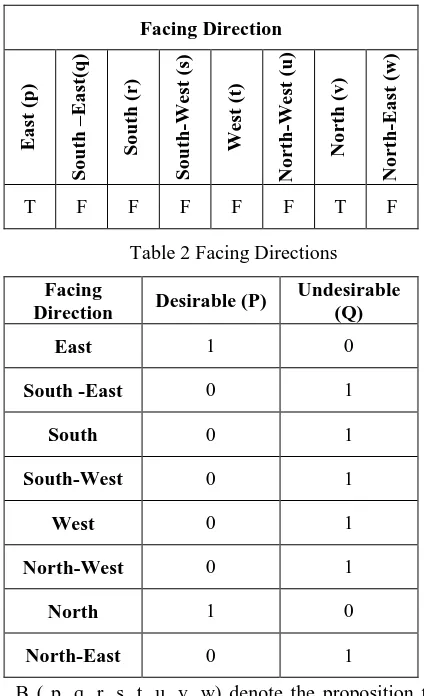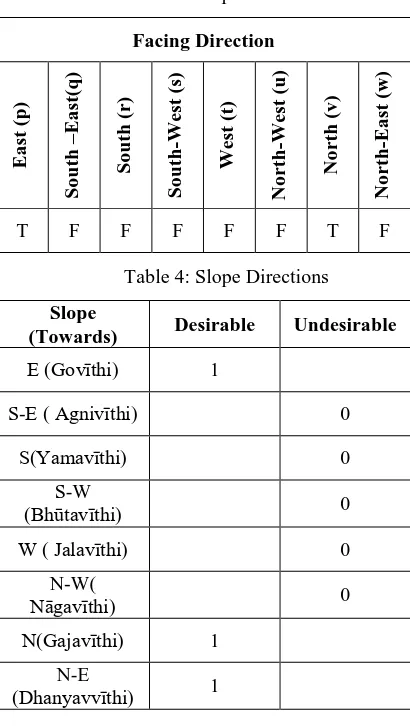Tautological Approach in Traditional Building Science
Rajasekhar P1, Babu T Jose2,
Research Scholar1, Emeritus Professor2 School of Engineering, Cochin University of Science and Technology1,2,
Email: raju58vaikom@gmail.com1
Abstract- Ancient Indian tradition of the building contains various scientific observations regarding the facing of the building and the slope of the ground. These observations seem to be scientifically apt while considering the geographical position and nature of our region. This study aims to bring out the scientific aspects behind the observations regarding the facing of buildings, the slope of land etc. The rules given in Vāstu texts seem to have prepared after considering all aspects and selecting the most appropriate from different perspectives. This might be probably through a method of selection similar to the tautological approach in modern mathematics.
Keywords- Vastu, Traditional Buildings, Facing of Buildings, Orientation of Buildings, Site slopes, Tautology, sun diagram.
1. INTRODUCTION
Indian tradition in building science and technology has its origin in antiquity. The general term which denotes Indian traditional building science is Vāstu. These Vāstu texts are available in Sanskrit and in many regional languages and all these have some common features and common philosophies which connects or append these texts to the Vedic corpus. The SthāpatyaVeda or the oldest of these texts is considered as an offshoot of Atharva Veda. Browsing through these texts, it could be seen that these texts deal with many topics including Astronomy, Astrology, Iconography, Rituals etc. apart from Architecture and Building Technology. As many religious and ritualistic elements are dealt conspicuously, these texts give Vāstu an impression of an occult science, to a modern reader. This impression has prevented the modern engineering community to keep aloof from Vāstu. As a part of the belief system, many Vāstu practitioners give consultancy to the believers and most of them are not really trained Engineers or Architects. This has again aggravated the situation and has pushed the age-old traditional wisdom aside as a pseudoscience. However, the fact remains that the Vāstu texts contain many logical, scientific and secular elements which are relevant and applicable even in modern times. Some findings and conclusions in these texts are stunning examples to demonstrate our glorious past and remarkable scientific heritage. Here in this paper, the principle of orientation which is one of the main canons of
Vāstuśāstra and the method of arriving at conclusion
regarding the facing of any building and its philosophical and logical approach leading to the diction is explained; mathematically it is a tautological paradigm. The present paper is based on
the Vāstu practice in Kerala which mainly based on a
15th cent. Text named Tantrasamuccaya (TS). Other texts quoted are later Vāstu texts written based TS and which are widely followed in Kerala.
The facing of any building and its philosophical and logical approach leading to the diction is explained; mathematically it is a tautological paradigm. The present paper is based on the Vāstu practice in Kerala which mainly based on a 15th cent. Text named
Tantrasamuccaya (TS). Other texts quoted are later
Vāstu texts written based TS and which are widely
followed in Kerala.
2. THE PRINCIPLE OF ORIENTATION
In Vāstuvidyā, placing a building in proper orientation
is very important and mandatory. The buildings are placed only in true cardinal directions. For this purpose, the process or experiment for determination of the four cardinal directions E-W-N-S is given in these texts which are mostly dealt with under
Diknirnaya,(MC) or Dikparicheda(SR). The most
While planning a building, its aspect or facing is of prime importance as per Vāstu. According to the above-explained principle of orientation in Vāstu, there are only four options i.e. East, South, West or North as buildings have to orient in the cardinal directions. Then the question is that, out of these four directions which are preferable? The preference is given explicitly in the texts. The relevant verse from the most acclaimed text on residential Vāstu written
by Tirumaṅgalattu Nīlakaṇṭhan named
Manuṣyālayacandrikā (c. 1550):
Ekamsyādyadidakṣiṇamgṛhamubhecettacca pāścātyakam
Tesaumyam ca gṛhatrike gṛhacatuṣke prācyametāni ca/ recommended and widely followed practice of facing was/is east.
In any building site (plot), from the aspect of stormwater drainage a gentle slope of the proposed land (ground), is always desirable. In Vastu also it is recommended that a slope in the proposed ground (plot) is desirable and there are also recommendations regarding the desirable slope direction. In this regard Srikumara also have stated the same recommendation. (Ref: Chapter-III-Verse 31and 32). These recommendations could be summarized as follows. Ground (Land) on which buildings are proposed must have slope towards North, North-East and East. All other directions of slopes (land gradient) are undesirable. The ground having a specific slope have specific names likes, Govīthi (E), Agnivīthi (S-E), Yamavīthi (S), Bhūtavīthi (S-W), Jalavīthi (W), Nāgavīthi (N-W), Gajavīthi (N), Dhanyavīthi (N-E).
1.1 Truth table of various propositions.
Table 3: Slope Directions
(Towards) Desirable Undesirable
E (Govīthi) 1 Otherwise, it is false. Refer to Table 5 and Table 6.
Table 5: Facing Directions
By definition of Conjunction, A(p) ^B(p) is true when both A(p) and B(p) are true. Similarly, for the propositions A(r) and B(r). For other propositions, for example, consider the truth table of A(r) ^B(r). Refer to Table 7. possible propositions are given in Table 7.
Table 7 Facing Directions
If all the truth values are T in all possible cases of A^ B then A^ B is a tautology. Truth values of A and B combined it be seen that houses facing East and North are only desirable and slope towards these directions
The above verses are quoted from the most acclaimed and widely followed text on residential Vāstu named
Manuṣyālayacandrikā written by Tirumaṅgalattu
Nīlakaṇṭhan (~b.1500 BCE near Tirur in Kerala) and
Ṥilparatna (1635); these texts are written to suit
environment etc. Hence the analysis of the above aspects of orientation and slope is analyzed with respect to Kerala region which lies between 8°N and 13°N in the Northern hemisphere. Due to the apparent movement of Sun, due to change in the declination, from September 22nd to March 21st the Sun is in the south side and by afternoon southern and western walls get heated up during this period. Since winter in the midland and coastal area of Kerala is very feeble, most of the period is very sunny except a few rainy days during October due to south-east monsoon. Similarly, by June 1st South West monsoon begins and prolongs roughly till September. Thus, most of the sunny days will be between September 22nd and March 21st when the sun is in the southern hemisphere. Hence from the position of the Sun, South and West facing becomes undesirable.
1.2 Slope of the ground:
The Earth-Sun relationship governs the amount of radiation received at a particular point on the Earth’s surface. The cosine law which states that the Intensity on a tilted surface equals the normal intensity times the cosine of the angle of incidence.
Cos
I
I
c
B.
Where Ic is the intensity on ground and IB
I
Bintensity of incident ray and β is the angle of incidence. Considering this, the desirable slopes to reduce the heat gain on the ground will be a reverse slope. The configuration of solar panels kept in Northern hemisphere itself is an ample proof and solar panels are also tilted according to the latitude of the place. Hence when the sun shines on the southern side, a slope towards North is desirable and also when the sun is in the West, an Eastern slope is desirable to reduce the heat load on the building. As heating of building in noon is more detrimental than in the morning in a tropical climate, western facing becomes undesirable. (Refer Table 8 and Table 9)
Table 8 Facing Directions Facing depending on Sun’s Path
Facing
Direction Desirable Undesirable
East 1 0
South -East 0 1
South 0 1
South-West 0 1
West 0 1
North-West 0 1
North 1 0
North-East 1 0
Table 9 Facing Directions
Slope of Ground-based on solar Intensity
Slope
(Towards) Desirable Undesirable
East 1
South -East 0
South 0
South-West 0
West 0
North-West 0
North 1
North-East 1
Monsoon Protection: In Kerala, monsoon blows from S-W predominantly during S-W Monsoon and sometimes from W and N-W and from E during S-E Monsoon. it is advisable to plots sloping from S-W to N-E so that rain will not hit directly during the predominant rainy season. Refer to Table 10and Table 11.
Table 10 Facing Directions
Facing depending on Monsoon
Facing
Direction Desirable Undesirable
East 1 0
South -East 0 1
South 0 1
South-West 0 1
West 0 1
North-West 0 1
North-East 1 0 Table 11 Facing Directions
Slope of Ground Monson
Slope
(Towards) Desirable Undesirable East 1
South -East 0
South 0
South-West 0
West 0
North-West 0
North 1
North-East 1
Thus, when the above two cases are combined and mathematical tautology is applied, it can be seen that houses facing East, North and North-East are only desirable and slope towards these directions are also recommended. However, from building planning point of view, as stated earlier, when the cardinal directions for facing are considered, it will reduce to North and East only. In the same way, scientifically, we can prepare a truth table considering many other aspects such as stormwater drainage, fire progression in case of a fire incident. Ground recharge etc. and can narrow down the results of desirable directions to North and East.
3. CONCLUSION
From the above, it can be inferred that Vāstu texts have followed a tautological approach in recommending various dos and don’ts though the details of the method through which they arrived at the results are not elaborated. Certain references and mentioning indicate that their methodology was scientific and logical and certainly these results are exactly matching when analyzed from a modern scientific perspective. In most of the traditional Indian texts, only results are given and these are given in the form of guidelines too. Similar to different building codes available in the modern period, these texts act as a guideline or building code. In the
absence of explanatory notes or elaborate interpretations of these texts, unless and until its validity is established with modern scientific backing with the rational approach it will not be palatable to a modern reader. On reading original Vastu texts and logically analyzing it, could be inferred that there are many parallels between modern Engineering philosophy and principles.
ACKNOWLEDGEMENT
Authors wish to acknowledge Dr Ram Kumar P. B, Associate Professor, Rajagiri School of Engineering and Technology, Kochi for his valuable suggestions and review of mathematical concepts included in this paper.
REFERENCE
[1] O. H Königsberger, T G Ingersoll, Alan Mayhew and S V Szokolay: “Manual of tropical housing and Building (Part one: Climatic design)” [2] Achuthan, A and Balagopala Prabhu TS,
“An Engineering commentary on Manuṣyālayacandrikā”,
Vastu Vidya Prathishtan, Calicut, 1998.
[3] Namboothiri, Cheruvally Narayanan (Tr.).. “Śilparatna of Śrikumāra”, Devi Book Stall, 2012.
[4] Sastri, T Ganapati, “Manuṣyālayacandrikā of Tirumaṅgalatt Nīlakaṇṭha”, Trivandrum Sanskrit Series, Travancore Manuscript Publication Department, Trivandrum, 1917.
[5] Kanippayoor Damodaran Namboothirippad. “Tantrasamuccaya of Chennas (silpa bhagam)”, Panchamgam Book Stall Kunnamkulam, 2003. [6] Vistasp Mehta, “Rational Vastu The Science
Sustainability”, bT square peg. (Online Booklet), 2005.
[7] Trembly J.P and Manohar R, “Discrete Mathematical Structures with Applications to Computer Science”, Tata McGraw–Hill Pub.Co.Ltd., New Delhi, 2003.
[8] Ralph. P. Grimaldi, “Discrete and Combinatorial Mathematics: An Applied Introduction”, 4/e, Pearson Education Asia, Delhi, 2002.
[9] Namboothiri, Cheuvally Narayanan (Tr.). (2008). Vastuvidya. DC Books, Kottayam



